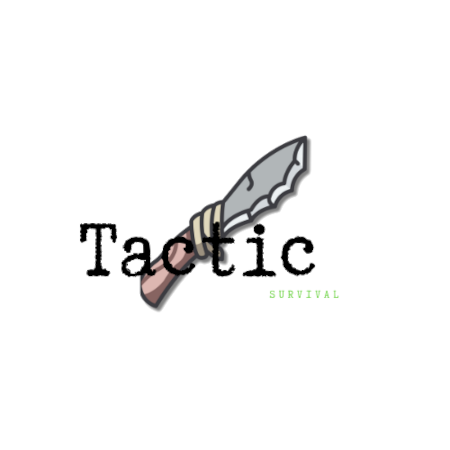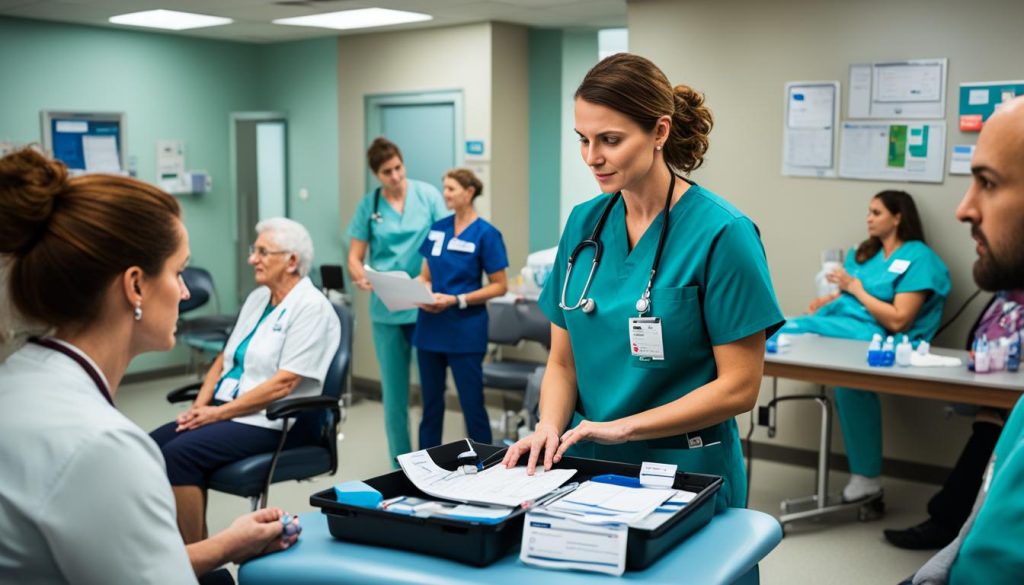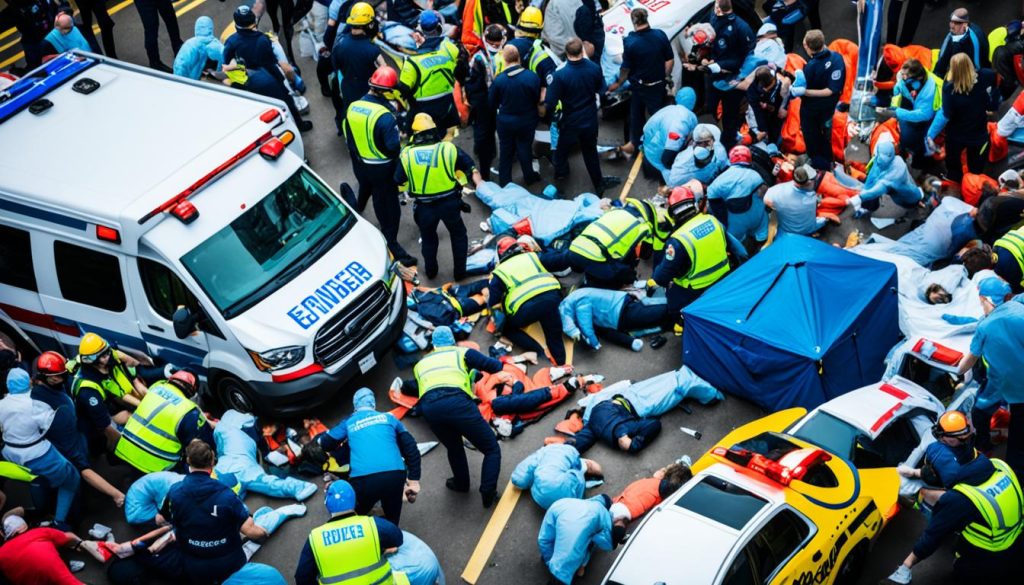Did you know that triage comes from military doctors in the 18th century? It’s from the French “trier,” which means to sort. Today, this sorting method helps in deciding who gets care first in an emergency.
Since 1964, hospitals have been using triage. It helps doctors and nurses quickly figure out who needs their help the most. This way, they can use their time and resources to save as many lives as possible. In the U.S., they often use the START system for adults and the Jump-START system for kids.
Triage happens in three steps: before reaching the hospital, at the scene, and as soon as they arrive in the hospital. This careful process makes sure each patient gets the right care without delay. It’s all about using what they have in the best way possible.
Key Takeaways:
- Triage is a healthcare technique that originated from military field doctors in the 18th century.
- The goal of triage is to prioritize patient care based on the severity of their injuries.
- The START system for adults and the Jump-START system for children are commonly used triage systems in the United States.
- Triage can be divided into prehospital triage, triage at the scene, and triage upon arrival at the emergency department.
- Implementing triage optimizes resource usage and timing, ensuring patients receive appropriate and timely care.
The Emergency Severity Index (ESI) Triage Algorithm
In medical emergencies, quick and accurate prioritization are key. The Emergency Severity Index (ESI) is a popular triage tool in the U.S. It helps nurses decide how urgently patients need care.
This system uses questions to evaluate a patient’s situation. It helps determine if someone needs life-saving help right away. For instance, it checks if a patient can breathe and has a pulse to see if they need immediate care.
The nurse also looks at the patient’s conscious level and vital signs. They check the hospital’s available resources to decide what care the patient needs. This method ensures patients get the best care for their condition’s seriousness.
The ESI Triage Algorithm Process
- Determine if the patient requires immediate life-saving interventions.
- Evaluate the patient’s level of consciousness and vital signs.
- Consider the number of hospital resources needed for disposition decisions.
- Assign a triage level based on the assessment.
The ESI helps nurses understand the emergency level each patient is in. It guides them in using hospital resources wisely. This means healthcare workers can focus on those with the most urgent needs.
“The ESI triage algorithm helps ensure that patients, regardless of their medical conditions, receive the level of care they require, while also helping hospitals manage their resources efficiently.”
Triage and knowing the ESI well are vital for those in the emergency field. Its use keeps triage consistent and effective across various healthcare facilities. This way, patients get the care they need quickly and correctly.
Emergency Department Triage in the United States
In the United States, emergency departments use the START and Jump-START systems. These systems help quickly check patients’ conditions. They look at vital signs to give the right care fast.
The START system looks at a patient’s pulse, how they breathe, and other signs. It decides how urgent their care is in just one minute. This helps doctors and nurses know who needs help the most.
For kids, the Jump-START system is used. It knows children may not be able to follow commands or breathe well. This system makes sure kids get the care they need right away.
The START and Jump-START systems can change their decision as a patient’s health changes. This means doctors keep checking on patients to make sure they are still getting the right care. It helps everyone in the ER get the help they need when they need it.
Benefits of Emergency Department Triage in the United States
Using these systems in U.S. emergency rooms brings many good things:
- It helps doctors use resources where they are most needed. So, the sickest people get help first. This lets all patients get the care they need quickly.
- It makes doctors’ jobs easier by giving them clear information right away. This lets them focus on treating the most serious cases first.
- People with urgent problems get help as soon as they need it. This can mean the difference between life and death.
- It makes the ER run more smoothly. Everyone knows who needs help first, which makes everything go faster.
- Doctors and nurses learn how to help quickly in an emergency. This training saves lives by letting medical teams act fast.
| Triage Technique | Benefits |
|---|---|
| START System | – Rapid calculation of triage status within 60 seconds – Objective assessment based on vital signs and key parameters – Efficient allocation of resources – Enhanced decision-making process |
| Jump-START System | – Tailored for pediatric patients’ unique needs and vulnerabilities – Considers increased likelihood of respiratory failure in children – Appropriate allocation of resources for pediatric care – Ensures timely interventions |
By using these systems, U.S. emergency rooms make sure everyone gets the right care. This means doctors can look after the most severe cases first. It makes the ER a place where everyone can get better.
Field and Disaster Triage
In big accidents or disasters, it’s vital to quickly figure out who needs immediate medical help. Triage systems in the field and during disasters are set up to do just that. They assess how badly hurt someone is and match them with the care they need, considering what help is available. The START (simple triage and rapid transport) and SALT systems are often used for this.
The START system looks at a patient’s ability to walk, their breathing, blood flow, and consciousness. People who can walk and follow commands are seen as “minor” cases. Those who are very badly hurt or can’t survive get different levels of care. This method lets medical experts focus on those who need help the most and quickly decide their care plan.
The SALT system is kind of like START, but it focuses on multiple injured people. It starts with checking who can walk, then it looks at their breathing. If someone isn’t breathing well, they get immediate help to save their life. This system makes sure those in critical need don’t wait for care.
Field and disaster triage demand fast thinking and clear communication among medical teams. They aim to offer the right care to the most people, quickly and accurately deciding who needs help first. Doing this well can really improve outcomes for the injured, even in very tough situations.
Example of START Triage Algorithm Categories:
| Triage Level | Description |
|---|---|
| Immediate (Red) | Patient requires immediate life-saving interventions and has the highest priority for medical attention. |
| Delayed (Yellow) | Patient has non-life-threatening injuries and can wait for medical care without their condition deteriorating rapidly. |
| Minor (Green) | Patient has minor injuries and can be treated and discharged without further medical intervention. |
| Expectant (Black) | Patient’s injuries are so severe that they are unlikely to survive even with medical treatment. Comfort measures may be provided. |
Benefits of Field and Disaster Triage:
- Enables rapid assessment and prioritization of patients based on their medical needs.
- Optimizes the use of limited resources in dire situations.
- Allows focus on providing immediate care to critical injuries.
- Enhances overall efficiency in responding to crises.
Using good triage like START and SALT is key to making sure people get the care they need in emergencies. These methods help medical teams to quickly make the best decisions in chaos. This saves lives and ensures medical help is as effective as possible in tough times.
The Concept of Advanced Triage
Advanced triage (AT) is crucial in healthcare, especially in high-traffic areas like hospitals’ emergency rooms. It’s a method where specially-trained nurses use specific guidelines after the first check.
This approach lets nurses work more independently and make quick but safe decisions. It speeds up patient care, makes them more comfortable, and boosts satisfaction levels.
Nurses need more learning and skills for advanced triage to work well. It’s key for them to have the right abilities to deal with triage’s challenges.
Advanced triage protocols help deal with issues like too many patients and not enough resources. They make the process smoother, improving how well patients do in the end.
Benefits of Advanced Triage:
- Improved efficiency in care delivery
- Enhanced patient comfort and satisfaction
- Reduced waiting time
- Optimized resource utilization
“Advanced triage allows nurses to provide safe and efficient care to patients with different levels of acuity, optimizing the use of resources and improving overall patient outcomes.”
Nurses’ work in triage, especially emergency situations, is crucial. Their skills help sort out patients quickly, ensuring timely care for the most urgent cases.
Continuous education is vital for nurses to keep their triage skills sharp. Staying updated in the field helps them make the best decisions for patients.
Advanced triage makes the whole system work better by using nurses’ expertise. It leads to better patient care, smarter use of resources, and effective emergency triage.
| Advantages of Advanced Triage | Challenges in Implementing Advanced Triage |
|---|---|
| Improved efficiency in care delivery | Limited resources and staffing |
| Enhanced patient comfort and satisfaction | Resistance to change from traditional triage methods |
| Reduced waiting time | Need for additional training and education |
| Optimized resource utilization | Integration of advanced technologies and protocols |
Benefits of Implementing Advanced Triage
Advanced triage helps in emergency departments. It benefits healthcare settings, patients, and professionals. With advanced triage, hospitals get better quality care and outcomes. They also better use their resources and increase efficiency.
Improved Patient Experience
Advanced triage cuts down on how long it takes to give patients medicine. This means patients get needed drugs faster. It makes patients feel less worried and more satisfied. Also, it helps get less urgent patients started on their care sooner. This means less stress for them and their families as they wait.
Enhanced Efficiency and Resource Utilization
Advanced triage makes emergency rooms work smoother by reducing wait times and how long patients are there. It figures out how serious patients’ needs are and treats them accordingly. This makes sure everyone gets the right care quickly. It uses resources better, too.
Optimized Patient Outcomes
Using advanced triage, healthcare workers can help all types of patients efficiently. Critical patients get seen to first, making sure no one in danger is left waiting. Quick and proper care makes for the best patient results and high care quality.
“Implementing advanced triage in emergency departments has proven to be beneficial in improving patient comfort, reducing waiting times, and optimizing resource utilization.”
Overall, advanced triage makes emergency rooms work better. This leads to happier patients, smarter resource use, and better patient health. Health systems can use this method to prioritize patients better. They give the right care quickly to each patient.
Future Directions in Triage Techniques
Triage techniques have improved emergency response over the years. But, there’s still space to make them better. Researchers are working on new ways to assess patients more accurately and use resources more wisely. They hope to perfect triage for the future.
New technology is setting the stage for the future of triage. Artificial intelligence (AI) is becoming a game-changer. It can sift through lots of data quickly and suggest the best actions in real time. By using AI, medical experts can offer better care to the most urgent cases.
Telemedicine is also changing how we do triage. It allows patients to see a doctor without being in the same place. This is especially helpful in far-off areas or during big emergencies. With the help of telemedicine, patients get to the right care faster, saving crucial time.
Training our healthcare workers well is key for future triage success. The field is always evolving with new methods and tech. So, doctors and nurses need to keep learning to use these tools effectively. Training must prepare them to handle the latest triage systems with ease.
| Statistics Data | Research Article |
|---|---|
| Accesses | 32k |
| Citations | 48 |
| Altmetric Score | 30 |
| Studies Included in Review | Nine |
| Triage Accuracy in Written Case Scenarios | Ranged from 56.2% to 73%, with an average of 58% |
| Underestimation in Triage Cases | Ranged from 13% to 27.6% |
| Single-Center Study Triage Accuracy | 70.1% in written case scenarios |
| Consensus in Delphi Process | 80% reached for scenarios used in the Pakistan study |
Redefining Triage Techniques for More Effective Emergency Care
The future of triage depends on new tech, research, and ongoing education. Artificial intelligence and telemedicine are leading the way. They can provide better, faster care. With continued support and innovation, triage can improve emergency care for everyone.
Conclusion
Triage techniques are key in emergencies, offering a methodical way to check patients, decide who goes first, and use resources wisely. They also help in big emergencies and disasters. Here, quick checks using signs like how well someone breathes, their blood flow, or how clear their thinking is, become crucial.
Improved triage also boosts how fast and well patients get handled in emergency areas. By always getting better and adjusting these techniques, medical groups make sure people are seen and treated right away. It’s very important for health workers to get the right training and keep learning. This helps them do their best in triage, which in turn, makes patient care better.
To wrap it up, methods like the Start Triage and others are vital in crises and prioritizing medical help. They let medical teams choose the most urgent cases based on patients’ signs and needs. When health systems work on their training and keep tweaking their methods, they’re able to provide quick and good care to everyone who needs it.


